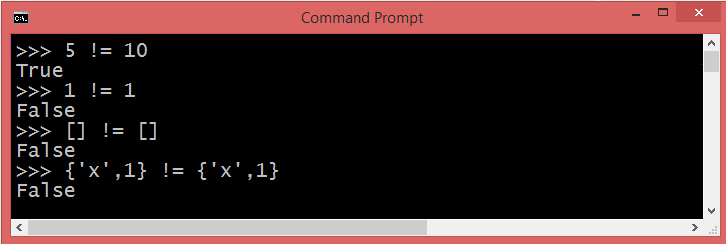

Let us demonstrate this with the below example. Now let us see an example where not equal to the operator can be defined as “is not” when using conditional loops like if … else. Therefore the not equal to operator prints, the operands have different values though the value is given is 5 to both operands where one is int, and the other is string type. In the above program, we can see we have declared two variable, x as an int data type with value 5 and y as a string data type with value “5”. Example #2Ĭode: print("Program to demonstrate not equal to operator with different data types of operands:") Let us demonstrate below with an example. In Python, when we are using not equal to operator, then we have to note that the two operands that are declared must be of the same data type else in Python, if both the operands have different data types, then it will return not equal. To see the above program to have the output as “False”, then we need to define the values of two operands x and y with the same value. We can see we are trying to print the result of the expression x != y, which will print “True” as both the given operands are not equal. In the above program, we can see we have declared two variables, x and y, which are considered as operands with values 5 and 3. Print("The manipulation after applying not equal to operator on above operands is as follows:") Print("The second operand with its value is as follows:") Print("The first operand with its value is as follows:") Example #1Ĭode: print("Program to demonstrate not equal to (!=) operator is as follows:") Now let us see an example to demonstrate the not equal to the operator (!=). In the above syntax, we saw that we can define “not equal to” in two ways in Python using “!=” or “is not” in the expressions or conditions and returns the Boolean value “True” or “False” having operands with the same type on both sides of the operator. Hope you now have a clear understanding of Python comparison operators.This statement or expression will return Boolean values such as “True” or “False”.

Less than or equal To (=) returns True if the value on the left is greater than or equal to that on the right.Not equal ( != ) is the exact opposite of the equal to operator.Equal to ( = ) returns True if the value of two operands is equal.Less than ( ) returns True if the value of the left operand is greater than the value of the right operand.Print("b is neither greater than nor equal to a")ī is either greater than or equal to b Summaryĭuring this tutorial, we have discussed 6 operators that programmers used to compare values, also called Python comparison operators, let us summarize them one by one. Print("b is either greater than or equal to a")

It will return True if the provided number or a variable is smaller than the given number or variable, otherwise, it will return False. It is used to check for the smaller value or variable containing a smaller value as compared with the other number or variable. There are 6 types of comparison operators in Python: There are several types of comparison operators, each performing a unique operation, let’s look at them one by one. Here there can be two possible outputs, either boolean True or False. Python comparison operators, also known as relational operators, are used in comparing two values and applying conditions respectively. In this tutorial, we will learn about all types of Comparison Operators and demonstrate them with examples to understand their working. In Python, operators can be divided into several categories based on their functionality such as Arithmetic Operators to perform mathematical operations, Comparison Operators to compare two values, Logical Operators to combine multiple conditions and evaluate whether they are True or False, Bitwise Operators to perform operations on the individual bits of a binary number, etc. For instance, the equal to ( = ) operator checks for equal values and returns True if they are equal, and False otherwise, whereas the not equal ( !=) operator does the exact opposite. Operators are symbols in programming languages that perform the operation on the operands and decide the operation type.


 0 kommentar(er)
0 kommentar(er)
